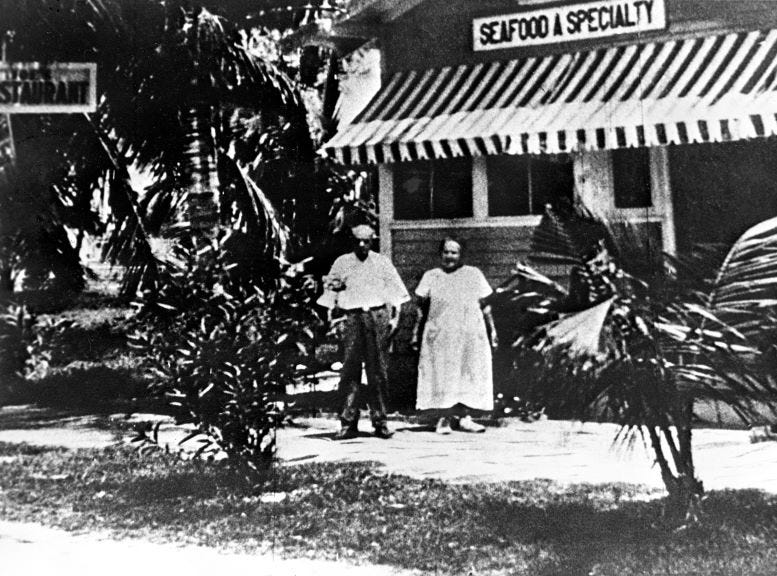Joe’s Restaurant on Miami Beach, 1920 - 1931
The story of Joe's Stone Crab restaurant's first decade in business. Joe Weiss opened his namesake restaurant on December 4, 1920, an establishment that has been a landmark for more than a century.
When the Weiss family opened Joe’s Restaurant in 1920, they likely had no idea that they started an institution that would still be thriving more than a century later. According to the family’s son, Jesse, Joe Weiss arrived in South Florida as early as 1913 upon his doctor’s request to help remedy a bad asthmatic condition. Joe spent one night in Miami and still had trouble breathing, so he traveled by ferry across the bay to explore the new City of Miami Beach and realized he could breathe without much difficulty. As he settled on the beach, Joe sent for his wife, Jennie, and son to join him in South Florida.
By the late 1910s, Joe got the opportunity to run a restaurant when a dining hall opened at Smith’s Casino, which was a beach and bathing establishment near the southern point of Miami Beach on Biscayne Avenue, today’s Southpoint Drive. Although Joe did not remain with this establishment long, he was there long enough to build a reputation for preparing quality fish dinners for the patrons who regularly dined at the restaurant. This is the story of the first decade of what would become Joe’s Stone Crab on Miami Beach.
Sunshine Inn at Smith’s Casino
On January 28, 1919, Fred Baessler sold his lease to operate a restaurant at Smith’s Casino, located at the eastern end of Biscayne Street on Miami Beach, to George A. Gloor, an established restauranteur from Detroit, Michigan. Fred sold Baessler Restaurant to Gloor in order to return to his hometown of New York to attend to personal business. This transaction turned out to be a rather fortunate event for Joe and Jennie Weiss.
By June 11, 1919, the Miami Herald published an article about the opening of the Sunshine Inn at Smith’s Casino. The paper had to be specific that this new establishment was part of the bathing casino because there was another established restaurant in Coconut Grove with the same name.
In an article published in the Miami Herald entitled “Beach Has a Dining Hall”, with a sub-headline of “Smith’s Casino Addition Excels Anything Else at Beach – Will Open in Season,” the writer announced the Sunshine Inn as follows:
“Miami Beach has an up-to-date and beautiful dining hall at Smith’s casino, owned by G.R. Gloor of Detroit, Michigan, and operated by Mr. and Mrs. Joe Weiss, caterers who have had experience in big hotels and eating places of the east.”
The new establishment consisted of a smaller dining room which was open year-round and a large dining hall which opened during the winter season to accommodate the influx of tourists and seasonal residents. Joe cooked and ran the kitchen, and Jennie managed the dining rooms and the operation of the dining hall. It took less than a year for Joe Weiss to establish a reputation as the best cook on the island. There were not many dining options at the time, but the restaurant’s diverse menu and Joe’s attention to quality had many regulars returning to the Sunshine Inn.
On November 2, 1920, George Gloor sold the lease for the Sunshine Inn to Rogelio Duran, a Cuban restauranteur from Havana, who took ownership of the establishment immediately. Although the press release wrote that the Weiss family would continue to manage the restaurant, the change of ownership did not sit well with Joe. Shortly after the announcement, Joe resigned from the Sunshine Inn to ponder his next move.
Joe Opens Restaurant in 1920

Loyal regulars of the dining hall asked about the whereabouts of their favorite cook after his disappearance from the establishment, but it became clear that Joe used the change of ownership of Sunshine Inn to make a change of his own. On November 19, 1920, the Miami Metropolis announced that Joe Weiss would open his own restaurant at 213 Biscayne Street, which was located across the street, and down the road, from Smith’s Casino.
On the day of the opening of Joe’s Restaurant on December 4, 1920, the Metropolis shared the back story on Joe’s inspiration for opening his own establishment:
“One day Joe disappeared after having been chef at Sunshine Inn for two years. Men who went there for fish dinners clamored for their favorite cook. They sought him out and induced Joe, who was taking a rest to consider his options. The demands of Joe’s friends have resulted in the latest eating place at the beach. There are private and public dining rooms, big kitchens and all kinds of equipment for specializing in shore dinners. Outside is a blazing electric sign, Joe’s, which tells the story to lots of men who have been sitting at Joe’s tables for years. Fred Holliday will be head waiter.”
The Weiss family residence at 213 Biscayne Street became the restaurant. The home was re-modeled to add a 9-by-24 porch dining room, enclosed in glass, and a new kitchen and other conveniences to operate a restaurant.
The Sunshine Inn regulars were always more loyal to Joe than the dining hall, and many of them filed across the street to fill Joe’s restaurant on a nightly basis. In addition to providing the best meal on the beach, Joe and Jennie ran a very clean operation. In May of 1921, the city’s hotel inspector evaluated all dining establishments on Miami Beach, and awarded Joe’s Restaurant the gold seal certificate for cleanliness. The rating was 96 percent which inspired Joe to prominently post the gold seal in the dining room.
Keep reading with a 7-day free trial
Subscribe to Miami History to keep reading this post and get 7 days of free access to the full post archives.




